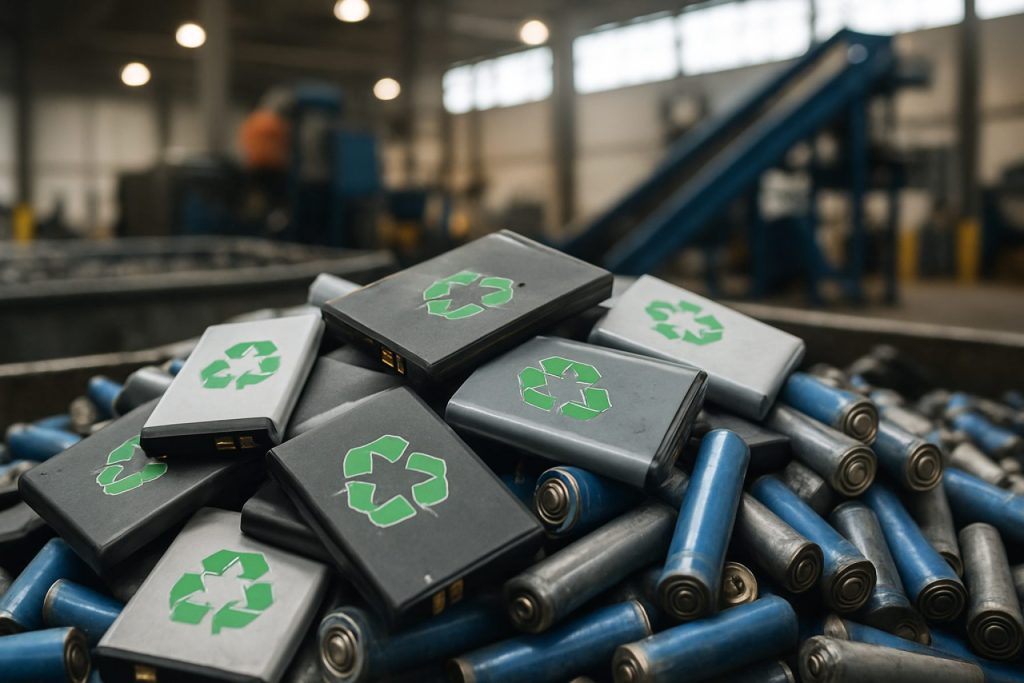
- Battery recycling is transforming waste into a powerful resource for lithium, cobalt, nickel, and manganese, critical to the new energy economy.
- The global battery recycling market is projected to nearly double in value by 2030, signaling massive industrial and environmental shifts.
- Asia-Pacific, especially China, Japan, and South Korea, leads in advanced recycling technology and circular supply chains, with traceable, AI-powered processes.
- Europe’s strict regulations push for genuine circularity and high recovery rates, while North America emphasizes technological innovation and domestic supply chains.
- Barriers include high costs, technical challenges in safe dismantling, and the need for automation, but advances in hydrometallurgy and AI are rapidly improving efficiency.
- Consumers are crucial—safe disposal, using certified drop-off points, and taking advantage of trade-in programs directly support the circular battery economy.
Batteries once faded quietly from our lives—discarded, forgotten, locked away in landfills. Now, legions of spent lithium packs and the ruins of electric vehicles are powering a seismic realignment in industry, policy, and environmental stewardship. The humble battery discard has become a linchpin for a richer, greener, and fiercely competitive future—an urgent contest unfolding from the heart of Asia to North America’s innovation labs.
A New Age of Alchemy
Colossal heaps of used batteries, emerging from yesterday’s smartphones and tomorrow’s Teslas, are no longer refuse. They are a resource coveted by governments and multinationals alike—a source for lithium, cobalt, nickel, and manganese, as precious in the new energy economy as oil was to the old. Analysts see the battery recycling industry doubling in value by 2030, soaring from $22.75 billion to $41.66 billion. Far more than a statistic, this surge signals a tectonic shift: a world where not just energy, but the very stuff that carries it, is reclaimed.
Asia-Pacific: Command Center of the Circular Revolution
Beneath city skylines where innovation pulses, the Asia-Pacific region forges ahead as the world’s recycling powerhouse. China, under sweeping clean-energy edicts, amasses over half of global recycling revenues. Manufacturers must not only power vehicles but shepherd their batteries back, closing the loop from mine to factory to consumer and—crucially—back again. South Korea and Japan, propelled by their electronic dynasties, refine these loops to near perfection, unveiling semi-automated plants where AI analyses, guides disassembly, and ensures traceability from cell to cathode.
Australia, with its mineral wealth, races into this space with swift strides—focusing on refining smelted waste into material pure enough for the next cycle. Meanwhile, India’s laws, mandating strict producer responsibility, are transforming a culture once marked by informal scavenging into one of traceable, industrial-scale reclamation.
Europe and North America: Harnessing Rules, Racing with Tech
Across the map, Europe’s unforgiving regulations galvanize action. The European Union’s new mandates demand real circularity—minimum recycled content in every battery, high recovery rates, billions invested in ‘gigafactories,’ and immense focus on traceable supply chains. European giants like Umicore have led the charge, turning e-waste into urban mines—harvesting metals with an efficiency now reaching 95%.
North America counters with innovation at warp speed. AI-powered robots from Redwood Materials and Li-Cycle, direct recycling labs in Canada, and partnerships binding carmakers to recyclers all spring from the need for domestic supply—and a hedge against global uncertainty. The U.S. and Canada channel billions into cutting-edge hydrometallurgy and green-tech, aiming for recycling methods as refined as the batteries themselves.
The Strategies and Players—And the Hunt for a Circle Unbroken
From Volkswagen’s closed-loop EV battery systems in Germany, to Panasonic’s sourcing of recycled battery-grade materials in the U.S., the global auto and electronics giants are weaving a tight network of alliances. Multiple routes to reclaiming value are shaking up the old “mines-to-market” model. The vertical integration trend is unmistakable—traditional recycling is out, and continuous redesign for reuse is in.
Meanwhile, mergers and blockbuster deals—like Ace Green Recycling’s massive partnership with Athena—accelerate the arms race for access to battery feedstock. It’s as much about securing tomorrow’s minerals as protecting shareholder value.
Barriers and Breakthroughs
The path isn’t without peril. Technical headaches abound: lithium-ion batteries, engineered for durability, are notoriously difficult to dismantle safely. Hydrometallurgical recycling, far cleaner than smelting, still needs advanced diagnostics, AI sorting, and automation to ensure profitability.
Financially, the capital expenditure is enormous. Establishing a basic lithium-ion plant in India can top $370,000—not counting compliance, labor, logistics, or huge energy draws. Yet the cost curve is bending as tech advances, making even small-scale recycling more feasible for local businesses and innovators worldwide.
The Homefront: Everyday Actions, Oversights, and Hacks
Recycling doesn’t belong exclusively to industry titans. Consumers and small businesses can tap local recycling programs, electronics retailers, and organizations like Call2Recycle to safely process their old batteries. Experts warn to always tape terminals, store batteries safely, and use certified drop-off points to avoid fires and hazards. Trade-in programs at mobile carriers and select retailers can even put cash back in consumers’ hands for their eco-conscious choices.
Security and equity concerns lurk at the margins. Data remnants in device batteries and the risk of waste being exported to countries with weak oversight have sparked calls for stronger international cooperation.
The Next Chapter: Batteries as Endless Resource
From the “urban mining” of e-waste in Belgium to Hydrovolt’s ultra-automated facility in Norway and Dubai’s integrated battery center, the smart money and the sharpest minds are betting on a future where waste disappears into an endless supply chain.
The bottom line—waste is no longer the end of the story; it is the beginning of a new economic and environmental chapter. In mastering battery recycling, nations and companies seize more than metals—they claim energy security, reduce carbon, and carve a path forward for Bloomberg, IEA, and any citizen concerned with tomorrow. To watch a mountain of spent batteries is to see not a liability, but the raw material for the world’s next leap forward.
Key Takeaway: Battery recycling is not just cleanup—it is strategy, innovation, and economic transformation. The true victors will be those who unlock the means to turn waste into perpetual wealth, fueling a future limited only by our capacity to reclaim, redesign, and renew.
Batteries: The New Gold—How Recycling Will Power the Future and Make You Money
The Rapid Rise of Battery Recycling: What Mainstream Coverage Misses
Battery recycling isn’t just a behind-the-scenes activity anymore—it’s becoming a cornerstone of the global energy revolution. With the lithium-ion battery market booming due to electric vehicles (EVs), smartphones, and renewable energy storage, the once-overlooked task of managing discarded batteries has evolved into a critical lever for sustainability, supply chain security, and economic growth. Here’s what you need to know about where the industry is headed, new life hacks, expert insights, key challenges, and actionable steps to benefit from this transformative trend.
Why Battery Recycling Matters More Than Ever
1. Soaring Demand for Critical Minerals
– Lithium, cobalt, and nickel are integral for EV batteries, grid storage, and consumer electronics.
– Reserves are finite and mining is often environmentally damaging; recycling is now vital to meet demand.
– BloombergNEF projects that recycled battery materials could meet up to 20% of lithium and 35% of cobalt demand by 2040 ([Bloomberg](https://www.bloomberg.com)).
2. Geopolitical and Economic Drivers
– China continues to dominate raw material supply and refining, giving recycling a strategic edge for the U.S. and Europe to shore up self-sufficiency.
– The U.S. Department of Energy and European Commission both identify battery recycling as a national security imperative ([IEA](https://www.iea.org)).
3. Legislative and Regulatory Forces
– The EU’s new Battery Regulation sets mandatory targets: 50% lithium, 90% cobalt/nickel/copper recovery rates by 2027, minimum recycled content in new batteries, and extended producer responsibility for manufacturers.
– The U.S. Infrastructure Investment and Jobs Act has earmarked billions for battery recycling and domestic supply chain development.
Breakthrough Technologies & Who’s Leading the Charge
Key Technologies:
– Hydrometallurgical Recycling: Uses water-based solvents—lower emissions & higher recovery rates than pyrometallurgy (smelting).
– Direct Recycling: Keeping cathode and anode material structures intact, leading to cheaper and energy-efficient remanufacturing.
– Robot-assisted Automated Disassembly: AI-driven systems (e.g., at Redwood Materials) reduce human error and safety risks.
Major Global Players:
– Asia-Pacific: CATL, GEM, JX Nippon Mining & Metals are pushing the boundaries of efficient, closed-loop recycling.
– Europe: Umicore, Hydrovolt, Fortum lead in advanced sustainability and regulatory compliance.
– North America: Redwood Materials, Li-Cycle, and Ascend Elements attract significant VC funding and pilot projects with major automakers.
How-To & Life Hacks: Safe Battery Recycling at Home
Step-by-Step:
1. Tape the Terminals: Prevent accidental short circuits or fire—crucial for lithium batteries.
2. Separate by Type: Don’t mix household alkalines with rechargeable or button-cell batteries.
3. Locate Certified Drop-Offs: Use Call2Recycle, Best Buy, or Mobile Carrier stores—never toss batteries in regular trash for safety and compliance.
4. Leverage Trade-Ins: Many mobile carriers and electronics stores now offer cash or credit for old phones and batteries.
5. Data Security: Remove SIM cards and wipe devices before recycling to safeguard personal information.
Market Forecast & Industry Trends
– The battery recycling industry could be worth over $45 billion by 2030—far outpacing legacy waste management sectors.
– Growth is fastest in regions with EV adoption and strict circular economy rules.
– Mergers & acquisitions will likely accelerate as carmakers and recyclers secure long-term feedstock.
Pros, Cons, and Limitations
Pros:
– Lessens ecological damage & mining waste
– Reduces reliance on volatile mineral supply chains
– Supports local economies and green tech jobs
Cons/Limitations:
– High upfront capital expenditure—smaller firms can struggle
– Technical barriers: Each battery chemistry differs; current recycling rate for lithium is below 5% globally, but rising
– Potential e-waste dumping in lax-regulation countries if not strictly monitored
Expert Insights & Predictions
– IEA and IEEFA forecast battery recycling to become a standard part of EV lifecycle by 2035.
– Dedicated “urban mining” centers might outperform traditional mining for certain metals by 2040.
– As battery technology (e.g., solid-state, sodium-ion) matures, recycling methods must adapt—industry leaders are heavily investing in R&D now.
Security & Sustainability
– New regulations require transparent “battery passports” for traceability—consumers and regulators can track where recycled materials originate.
– The cleanest recycling plants are achieving 95%+ material recovery, slashing carbon emissions compared to primary production.
Real-World Use Cases
– Volkswagen’s Salzgitter Plant: Recycles 3,600 battery packs per year—aims to source a significant % of new batteries from recovered materials.
– Norway’s Hydrovolt: Automated facility processes all EV batteries from the national market, feeding clean metals to European gigafactories.
Most Pressing Questions—Answered
Q: Can battery recycling really meet future EV demand?
A: By 2030, up to 15% of battery metals for new EVs could come from recycled sources; this share will rise as the first major EV fleets reach end-of-life.
Q: Is recycling always better than mining?
A: For key metals like cobalt and nickel, recycling cuts energy and carbon significantly, but must be managed to avoid e-waste dumping.
Q: What should I do with dead gadgets?
A: Never throw batteries into household waste. Use official drop-offs, and take advantage of retailer incentives to recycle safely.
Reviews & Comparisons
– Redwood Materials vs. Li-Cycle: Redwood leads in U.S.-based innovation and EV battery partnerships. Li-Cycle is expanding into Europe and Canada with unique hydrometallurgical processes.
– Umicore vs. Fortum: Umicore excels in high-efficiency urban mining and direct partnerships with automakers, Fortum has pioneered low-carbon recycling for Europe’s Nordic markets.
Actionable Tips: Start Today
1. Check your local electronics retailer or town website for battery collection programs.
2. Organize or join a community e-waste recycling drive.
3. If buying new devices, choose brands with clear, transparent recycling schemes.
4. Advocate for local regulations that mandate proper battery disposal and recycling.
—
Bottom Line:
Battery recycling is fast becoming as important as battery manufacturing itself. For everyone—governments, industries, and consumers—understanding and participating in this revolution is essential for a cleaner, more secure future. Stay informed, recycle smart, and be part of tomorrow’s circular economy.
For more about the growing impact of batteries and energy policy, visit [Bloomberg](https://www.bloomberg.com) and [IEA](https://www.iea.org).
—
Keywords: battery recycling, circular economy, EV batteries, lithium-ion recycling, hydrometallurgy, battery regulations, green technology, urban mining, battery supply chain, sustainable energy



